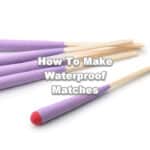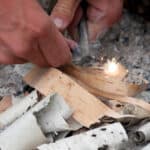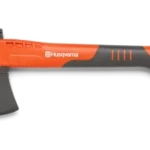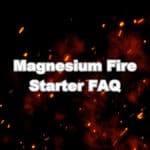Starting a fire can be challenging, especially in tough conditions. Did you know ferro rods are a go-to solution for this problem? This article will explain how these amazing tools work to create fire easily and efficiently.
Table of Contents
- Understanding Ferrocerium: What It Is & How it Works
- The Science Behind Ferro Rod Fire Starters
- How Ferro Rods Differ From Flint and Magnesium
- Practical Use of Ferro Rods
- Conclusion
- FAQ
- What are the best practices for using a Ferro Rod effectively?
- Can Ferro Rods work in wet conditions?
- How do I use a ferro rod when the weather is really bad?
- What tricks can I use to get better sparks from a ferro rod?
- What happens if I use different materials to strike a ferro rod?
- How do I know when it’s time to replace a ferro rod?
- Does being up in the mountains affect how a ferro rod works?
- What’s the best type of tinder to use with a ferro rod?
Key Takeaways
- Ferro rods are made from ferrocerium, a special mix of metals including rare earth elements like cerium and lanthanum. This blend creates sparks when struck against something hard.
- When you strike a ferro rod with a sharp object, it shaves off tiny pieces that quickly heat up and ignite at around 3,000°C/5,430°F, producing hot sparks perfect for starting fires.
- Unlike flint and steel or magnesium fire starters, ferro rods don’t need carbon steel or actual flint rock to work. Their unique material composition makes them more efficient at sparking fires in various conditions.
- For best results using a ferro rod, choose the right striker (like a high-carbon steel blade), prepare your tinder first, hold the rod close to the tinder, and use firm pressure while scraping at an angle.
- Keeping your ferro rod dry extends its life and effectiveness even though it can work when wet; regular practice improves technique, ensuring readiness for real-life survival situations.
Understanding Ferrocerium: What It Is & How it Works
Ferrocerium is a remarkable pyrophoric alloy invented in 1903 by Austrian scientist Baron Carl Auer von Welsbach. This precisely engineered material consists of:
- 41.8% Cerium
- 21.8% Lanthanum
- 20.8% Iron
- 5.4% Neodymium
- 4.4% Praseodymium
- 3.1% Magnesium
- 2.7% Other rare earth metals
When struck by something hard and sharp, like a carbon steel blade, this unique composition creates an extraordinary reaction. The striking action scrapes off tiny shavings that rapidly oxidize due to friction, igniting at an impressive temperature of 3,000°C/5,430°F.
A quality ferro rod demonstrates exceptional durability, capable of delivering between 8,000 to 10,000 strikes over its lifetime. This remarkable longevity makes it an invaluable tool for both survival situations and regular outdoor activities.
Despite containing a small percentage of magnesium (about 2%), ferro rods shouldn’t be confused with traditional magnesium fire starters. Instead of relying on carbon steel, ferro rods utilize iron or iron oxide as a key component, making them more versatile and efficient at generating sparks.
This innovative combination of elements makes ferrocerium rods incredibly effective for starting fires across various outdoor scenarios—from routine camping to emergency situations. The material’s unique properties ensure reliable performance even in challenging conditions, demonstrating why it has become a cornerstone of modern fire-starting technology.
The Science Behind Ferro Rod Fire Starters
Ferro rods use a clever mix of metals to create hot sparks. This process is about the right materials hitting each other, making it easy to start fires outdoors.
The Role of Friction and Oxidation
Striking a ferro rod with a steel striker creates friction. This action scrapes off tiny shavings of the ferro-cerium alloy. These shavings heat up quickly due to the intense friction, reaching temperatures of 3,000°C/5,430°F.
At such high temperatures, the shavings ignite and produce white-hot sparks.
Oxidation plays a key role, too. Once the heated shavings come into contact with air, they oxidize rapidly. This quick oxidation process makes the sparks visibly bright and capable of starting a fire when they land on combustible material like tinder or char cloth.
The combination of friction and rapid oxidation ensures that ferro rods can be reliable tools for making fire in survival situations, generating showers of sparks on demand.
The Generation of Sparks
Ferro rods work their magic through a simple yet fascinating process. A hard, sharp object strikes the rod, shaving off tiny pieces of ferrocerium. Due to the friction, these shavings quickly heat up and reach their ignition temperature in an instant.
Burning at an impressive 3,000°C/5,430°F, they create bright sparks that are more than hot enough to start a fire.
Each spark is a molten metal flake burning in oxygen from the air. This reaction is not just any burn—it’s an intense burst of energy ready to turn tinder into flames. The high temperature ensures that even damp or challenging materials can catch fire with proper preparation.
Moving on, let’s explore “The Burning Secret of Flint and Steel.”.
The Burning Secret of Flint and Steel
Flint and steel fire-starting relies on a fascinating process. Striking flint against steel produces tiny sparks. These sparks are actually small pieces of the steel that heat up from the friction and react with oxygen in the air to ignite.
The real secret lies in this rapid and exothermic reaction between iron (steel) and oxygen, which releases heat. This method has been used for centuries as a reliable way to create fire, playing a crucial role in both survival settings and everyday tasks before the era of matches and lighters.
Performance in Various Conditions
Ferro rods excel in a wide range of environments, outperforming many traditional fire-starting methods:
| Fire Starter | Spark Temperature | Weather Resistance |
|---|---|---|
| Ferro Rod | ~3300°C | Excellent |
| Matches | ~800°C | Poor |
| Lighter | ~1100°C | Moderate |
The intense heat generated by ferro rods allows them to function effectively even in wet or windy conditions. For optimal performance, choose ferro rods between 3mm to 6mm in thickness. Larger diameters provide more material for strikes but may require more force to generate sparks.
How Ferro Rods Differ From Flint and Magnesium
Ferro rods stand out because they contain rare earth elements not found in flint or magnesium fire starters. This unique composition makes ferro rods more efficient at sparking fires.
Magnesium fire starters, on the other hand, have about 2% magnesium and rely on shavings to catch a spark, which then ignites due to its high flammability.
Unlike natural flint used with steel for traditional firemaking, ferro rods do not require carbon steel or any form of actual flint rock to work. Their sparks come from striking the rod itself, which is made of a pyrophoric alloy known as ferrocerium.
This material spontaneously produces hot sparks when scraped against a rough surface, making it easy and reliable to start fires in various conditions.
Practical Use of Ferro Rods
Mastering the use of ferro rods can turn you into a fire-starting wizard, even in tough conditions. These simple tools easily deliver reliable sparks to ignite your campfire, barbecue, or emergency signal.
Ideal Size and Shape of a Ferro Rod
The perfect ferro rod strikes a balance between being easy to carry and effective in use. Most outdoor enthusiasts agree that a rod measuring 5-6 inches long and 3/8 inch in diameter hits the mark.
This size is not too bulky, making it ideal for bug-out bags or keychains, yet it’s substantial enough to handle easily when striking sparks.
The shapes of ferro rods vary, offering different benefits. Some are cylindrical, which is straightforward and efficient for general use. Others feature ridges or facets designed to increase the surface area.
This design tweak helps produce more sparks with each strike, making fire-starting quicker even in difficult conditions.
Striking the Ferro Rod
Striking a ferro rod correctly is key to lighting a fire efficiently. This process generates white-hot sparks that can ignite a wide range of tinder, thanks to the rod’s ability to burn at temperatures of 3,000°C/5,430°F.
- Hold your ferro rod firmly—Grip one end of the rod tightly with one hand, ensuring it’s secure and won’t slip during use.
- Position your striker properly—Place a carbon steel blade or any hard, sharp object against the top edge of the rod at an angle.
- Apply pressure on the rod—Press down slightly with the striker. This ensures you shave off tiny bits of metal.
- Drag the striker along the rod—Quickly pull back the striker along the length of the ferro rod towards you. Keep it steady and forceful.
- Aim sparks toward your tinder—Direct them onto a pile of dry leaves, paper, or any chosen tinder box to catch them effectively.
- Practice makes perfect—It might not spark into flames on your first try, so keep practicing this motion until you master generating sparks consistently.
Tips for Using a Ferrocerium Rod
Using a ferrocerium rod correctly can make starting a fire much easier, especially in survival situations. These rods, often called “firesteel,” spark at temperatures of 3,000°C/5,430°F, making them highly effective for outdoor adventures.
- Choose the right striker—A high-carbon steel blade or a dedicated striker works best. The harder the striker’s surface, the more sparks you’ll produce.
- Prepare your tinder first—Gather small, dry materials that catch fire easily. Place them where you can quickly transfer sparks from your ferro rod.
- Hold the ferro rod close to the tinder—Minimize the distance between the rod and your tinder to ensure sparks directly hit their target.
- Use firm pressure—Press hard as you scrape the striker along the length of the ferro rod to create bright, hot sparks.
- Scrape at an angle—Positioning your striker at a 45-degree angle increases friction and spark production.
- Protect your ferro rod from moisture—Keep it dry when not in use; even though it can work when wet, moisture can decrease its lifespan and effectiveness.
- Practice makes perfect—Regular practice improves technique and efficiency, ensuring you’re ready when you really need it.
Maintenance and Long-Term Care
To ensure your ferro rod remains in peak condition:
- Storage: After use, store your ferro rod in a dry place. For added protection, consider applying:
- A thin coating of mineral oil
- A layer of clear nail polish
- A protective wax coating
- Rust Prevention: While ferrocerium doesn’t rust like iron, the steel striker can corrode. Keep it dry and lightly oiled to prevent rust.
- Regular Cleaning: Occasionally clean your ferro rod with a soft cloth to remove any debris or oxidation.
- Proper Use: Always scrape the rod with a sharp edge at a 45-degree angle for the best spark production and to minimize wear.
By following these maintenance tips, you can significantly extend the life and reliability of your ferro rod, ensuring it’s always ready when you need it most.
Conclusion
Ferro rods combine science and survival, igniting flames with a spark. Striking these rods unleashes a dance of physics and chemistry, where friction meets rare earth elements to create fire.
They are not just tools but gateways to understanding deeper scientific principles in action. This fusion of knowledge empowers adventurers off the grid, offering warmth and light in challenging conditions.
Fire starting becomes not only essential for survival but also a fascinating glimpse into material science at work.
FAQ
What are the best practices for using a Ferro Rod effectively?
For effective use, it’s recommended to choose the right striker, prepare your tinder before striking, hold the rod close to the tinder, and apply firm pressure while scraping the rod at an angle. Regular practice and keeping the rod dry are also advised to maintain efficiency.
Can Ferro Rods work in wet conditions?
Yes, Ferro Rods can function when wet. However, keeping them dry is recommended to extend their lifespan and ensure optimal performance, as moisture can decrease the effectiveness of the sparks generated.
How do I use a ferro rod when the weather is really bad?
When dealing with bad weather, change your technique to match the conditions. Use more pressure when striking in wet conditions. Keep your striker dry and protect your work area from rain or snow. Waterproof tinder like waxed cotton balls works best in wet weather. In cold or high-altitude areas, strike harder and focus more on spark placement.
What tricks can I use to get better sparks from a ferro rod?
Try these proven techniques to improve your success rate. For bigger ferro rods, use the “pin and pull” method – hold the rod steady and pull your striker toward you. With smaller rods, try the “thumb assist” technique by using your thumb to guide the striker. Keep your strikes at a 45-degree angle for the best sparks. If you’re not getting good sparks, try pressing harder or adjusting your angle until you find what works best.
What happens if I use different materials to strike a ferro rod?
Different striker materials can significantly impact spark quality and rod longevity. While the back of a knife is common, specialized scrapers made of tungsten carbide can produce more consistent sparks while causing less wear on the rod.
How do I know when it’s time to replace a ferro rod?
Look for significant grooving, uneven wear patterns, or difficulty producing consistent sparks. A well-maintained ferro rod typically lasts for 12,000-15,000 strikes before showing these signs of degradation.
Does being up in the mountains affect how a ferro rod works?
Higher altitudes with lower oxygen levels can affect the oxidation process, requiring slightly different techniques. Above 10,000 feet, you may need to adjust your striking angle and apply more pressure to achieve optimal spark generation.
What’s the best type of tinder to use with a ferro rod?
The extreme heat from ferro rod sparks requires specific tinder characteristics. Materials with high surface area and low ignition temperatures, like char cloth or certain fungal species, work better than standard paper or dry grass.







Leave a Reply